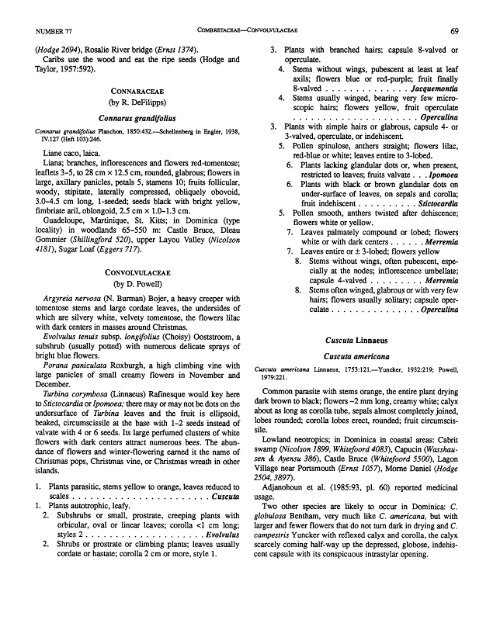Flora of Dominica, Part 2 - Smithsonian Institution Libraries
Flora of Dominica, Part 2 - Smithsonian Institution Libraries
Flora of Dominica, Part 2 - Smithsonian Institution Libraries
You also want an ePaper? Increase the reach of your titles
YUMPU automatically turns print PDFs into web optimized ePapers that Google loves.
NUMBER 77<br />
COMB RETACEAE~ONVOLVUIACEAE 69<br />
(Hodge 2694), Rosalie River bridge (Ermr 1374).<br />
Caribs use the wood and eat the ripe seeds (Hodge and<br />
Taylor, 1957:592).<br />
CONNARACEAE<br />
(by R. DeFilipps)<br />
Connarus grand(fo1ius<br />
Conmrus grandifolius F'lanchon, 1850:432.-SChellenberg in Engler, 1938,<br />
IV.127 (Heft 103):246.<br />
Liane caco, laica.<br />
Liana; branches, inflorescences and flowers red-tomentose;<br />
leaflets 3-5, to 28 cm x 12.5 cm, rounded, glabrous; flowers in<br />
large, axillary panicles, petals 5, stamens 10; hits follicular,<br />
woody, stipitate, laterally compressed, obliquely obovoid,<br />
3.0-4.5 cm long, 1-seeded; seeds black with bright yellow,<br />
fimbriate aril,.oblongoid, 2.5 cm x 1.0-1.3 cm.<br />
Guadeloupe, Martinique, St. Kitts; in <strong>Dominica</strong> (type<br />
locality) in woodlands 65-550 m: Castle Bruce, Dleau<br />
Gommier (Shillingford 520), upper Layou Valley (Nicolson<br />
4181), Sugar Loaf (Eggers 717).<br />
CONVOLWLACEAE<br />
(by D. Powell)<br />
Argyreia nervosa (N. Burman) Bojer, a heavy creeper with<br />
tomentose stems and large cordate leaves, the undersides <strong>of</strong><br />
which are silvery white, velvety tomentose, the flowers lilac<br />
with dark centers in masses around Christmas.<br />
Evolvulus tenuis subsp. longifolius (Choisy) Ooststroom, a<br />
subshrub (usually potted) with numerous delicate sprays <strong>of</strong><br />
bright blue flowers.<br />
Porana paniculata Roxburgh, a high climbing vine with<br />
large panicles <strong>of</strong> small creamy flowers in November and<br />
December.<br />
Turbina corymbosa (Linnaeus) Rafinesque would key here<br />
to Stictocardia or Zpomoea; there may or may not be dots on the<br />
undersurface <strong>of</strong> Twbina leaves and the fruit is ellipsoid,<br />
beaked, circumscissile at the base with 1-2 seeds instead <strong>of</strong><br />
valvate with 4 or 6 seeds. Its large perfumed clusters <strong>of</strong> white<br />
flowers with dark centers attract numerous bees. The abundance<br />
<strong>of</strong> flowers and winter-flowering earned it the name <strong>of</strong><br />
Christmas pops, Christmas vine, or Christmas wreath in other<br />
islands.<br />
1. Plants parasitic, stems yellow to orange, leaves reduced to<br />
scales ....................... Cuscuta<br />
1. Plants autotrophic, leafy.<br />
2. Subshrubs or small, prostrate, creeping plants with<br />
orbicular, oval or linear leaves; corolla c1 cm long;<br />
styles 2 .................... Evolvulus<br />
2. Shrubs or prostrate or climbing plants; leaves usually<br />
cordate or hastate; corolla 2 cm or more, style 1.<br />
3. Plants with branched hairs; capsule 8-valved or<br />
operculate.<br />
4. Stems without wings, pubescent at least at leaf<br />
mils; flowers blue or red-purple; fruit finally<br />
8-valved .............. Jacquemontia<br />
4. Stems usually winged, bearing very few microscopic<br />
hairs; flowers yellow, fruit operculate<br />
..................... Operculina<br />
3. Plants with simple hairs or glabrous, capsule 4- or<br />
3-valved, operculate, or indehiscent.<br />
5. Pollen spinulose, anthers straight; flowers lilac,<br />
red-blue or white; leaves entire to 3-lobed.<br />
6. Plants lacking glandular dots or, when present,<br />
Zpomoea<br />
restricted to leaves; fruits valvate ...<br />
6. Plants with black or brown glandular dots on<br />
under-surface <strong>of</strong> leaves, on sepals and corolla;<br />
fruit indehiscent .......... Stictocardia<br />
5. Pollen smooth, anthers twisted after dehiscence;<br />
flowers white or yellow.<br />
7. Leaves palmately compound or lobed; flowers<br />
white or with dark centers ...... Merremia<br />
7. Leaves entire or k 3-lobed; flowers yellow<br />
8. Stems without wings, <strong>of</strong>ten pubescent, especially<br />
at the nodes; inflorescence umbellate;<br />
capsule 4-valved ......... Merremia<br />
8. Stems <strong>of</strong>ten winged, glabrous or with very few<br />
hairs; flowers usually solitary; capsule operculate<br />
............... Operculina<br />
Cuscuta Linnaeus<br />
Cuscuta americana<br />
Cuscufa americunu Linnaeus, 1753:121.--Yuncker,<br />
1979221.<br />
1932:219; Powell,<br />
Common parasite with stems orange, the entire plant drying<br />
dark brown to black; flowers -2 mm long, creamy white; calyx<br />
about as long as corolla tube, sepals almost completely joined,<br />
lobes rounded; corolla lobes erect, rounded; fruit circumscissile.<br />
Lowland neotropics; in <strong>Dominica</strong> in coastal areas: Cabrit<br />
swamp (Nicolson 1899, Whitefoord 4083), Capucin (Wasshausen<br />
& Ayensu 386), Castle BNCe (Whitefoord SSOO), Lagon<br />
Village near Portsmouth (Ernst 1053, Morne Daniel (Hodge<br />
2504,3897).<br />
Adjanohoun et al. (1985:93, pl. 60) reported medicinal<br />
usage.<br />
Two other species are likely to occur in <strong>Dominica</strong>: C.<br />
globulosa Bentham, very much like C. umericana, but with<br />
larger and fewer flowers that do not turn dark in drying and C.<br />
campestris Yuncker with reflexed calyx and corolla, the calyx<br />
scarcely coming half-way up the depressed, globose, indehiscent<br />
capsule with its conspicuous intrastylar opening.
















